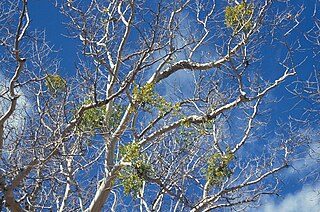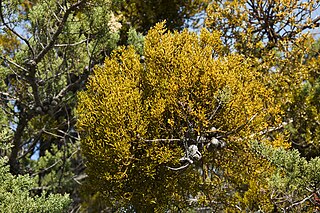
The phainopepla or northern phainopepla is the most northerly representative of the mainly tropical Central American family Ptiliogonatidae, the silky flycatchers. Its name is from the Greek phain pepla meaning "shining robe" in reference to the male's plumage.

The black-tailed gnatcatcher is a small, insectivorous bird which ranges throughout the Sonoran and Chihuahuan Deserts of the southwestern United States and northern Mexico. It is nonmigratory and found in arid desert areas year-round.

Calocedrus decurrens, with the common names incense cedar and California incense-cedar, is a species of conifer native to western North America. It is the most widely known species in the genus, and is often simply called 'incense cedar' without the regional qualifier.

Phoradendron is a genus of mistletoe, native to warm temperate and tropical regions of the Americas. The center of diversity is the Amazon rainforest. Phoradendron is the largest genus of mistletoe in the Americas, and possibly the largest genus of mistletoes in the world. Traditionally, the genus has been placed in the family Viscaceae, but recent genetic research acknowledged by the Angiosperm Phylogeny Group shows this family to be correctly placed within a larger circumscription of the sandalwood family, Santalaceae.

Kemp's gerbil is a species of rodent. Mammal Species of the World considers G. kempi and G. gambianus to be synonyms, however the IUCN has assessed each taxon as were they different species.
Blakea madisonii is a species of plant in the family Melastomataceae. It is endemic to Ecuador. Its natural habitat is subtropical or tropical moist montane forests.
Guzmania madisonii is a species of plant in the family Bromeliaceae. It is endemic to Ecuador. Its natural habitats are subtropical or tropical moist lowland forests and subtropical or tropical moist montane forests. It is threatened by habitat loss.

Helicia is a genus of 110 species of trees and shrubs, constituting part of the plant family Proteaceae. They grow naturally in rainforests throughout tropical South and Southeast Asia, including India, Sri Lanka, Indochina, Peninsular Malaysia to New Guinea and as far south as New South Wales.
Phoradendron aequatoris is a species of plant in the Santalaceae family. It is endemic to Ecuador. Its natural habitat is subtropical or tropical moist lowland forests.
Phoradendron canzacotoi is a species of plant in the Santalaceae family. It is endemic to Ecuador. Its natural habitat is subtropical or tropical moist montane forests.
Phoradendron pomasquianum is a species of plant in the Santalaceae family. It is endemic to Ecuador. Its natural habitat is subtropical or tropical moist montane forests.
Phoradendron wiensii is a species of plant in the Santalaceae family. It is endemic to Ecuador. Its natural habitat is subtropical or tropical moist montane forests.

Phoradendron leucarpum is a species of mistletoe in the Viscaceae family which is native to the United States and Mexico. Its common names include American mistletoe, eastern mistletoe, hairy mistletoe and oak mistletoe. It is native to Mexico and the continental United States. It is hemiparasitic, living in the branches of trees. The berries are white and 3–6 millimeters (0.12–0.24 in). It has opposite leaves that are leathery and thick. Ingesting the berries can cause "stomach and intestinal irritation with diarrhea, lowered blood pressure, and slow pulse". This shrub can grow to 1 meter (3.3 ft) by 1 meter (3.3 ft).
Phoradendron libocedri is a species of flowering plant in the sandalwood family known by the common name incense-cedar mistletoe. It is native to western North America from Oregon to Baja California, where it grows in forests on its host tree, the California incense-cedar.

Phoradendron macrophyllum is a species of flowering plant in the sandalwood family known by the common names Colorado Desert mistletoe, bigleaf mistletoe, and Christmas mistletoe. It is native to western United States and northern Mexico from Oregon to Colorado to Texas to Baja California, where it grows in many types of wooded habitat at elevations up to 1700 m.

The World's 25 Most Endangered Primates is a list of highly endangered primate species selected and published by the International Union for Conservation of Nature (IUCN) Species Survival Commission (SSC) Primate Specialist Group (PSG), the International Primatological Society (IPS), Global Wildlife Conservation (GWC), and Bristol Zoological Society (BZS). The IUCN/SSC PSG worked with Conservation International (CI) to start the list in 2000, but in 2002, during the 19th Congress of the International Primatological Society, primatologists reviewed and debated the list, resulting in the 2002–2004 revision and the endorsement of the IPS. The publication was a joint project between the three conservation organizations until the 2012–2014 list when BZS was added as a publisher. The 2018–2020 list was the first time Conservation International was not among the publishers, replaced instead by GWC. The list has been revised every two years following the biannual Congress of the IPS. Starting with the 2004–2006 report, the title changed to "Primates in Peril: The World's 25 Most Endangered Primates". That same year, the list began to provide information about each species, including their conservation status and the threats they face in the wild. The species text is written in collaboration with experts from the field, with 60 people contributing to the 2006–2008 report and 85 people contributing to the 2008–2010 report. The 2004–2006 and 2006–2008 reports were published in the IUCN/SSC PSG journal Primate Conservation,, since then they have been published as independent publications.

Phoradendron tomentosum, the leafy mistletoe, hairy mistletoe or Christmas mistletoe, is a plant parasite. It is characterized by its larger leaves and smaller berries than dwarf mistletoe. Leafy mistletoe seldom kill but they do rob their hosts of moisture and some minerals, causing stress during drought and reducing crop productions on fruit and nut trees. Leafy mistletoe has the ability to photosynthesize on its own but it relies on other plants in order to obtain its nutrients. It attaches itself to a tree and then grows haustoria, in order to get the food and water it needs.
Oak mistletoe is a common name for several plants and may refer to:

Phoradendron bolleanum, commonly called Bollean mistletoe, is a species of plant in the sandalwood family that is native to the desert southwest, California and southern Oregon in the United States.











